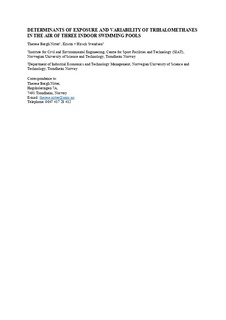Determinants of Exposure and Variability of Trihalomethanes in the Air of Three Indoor Swimming Pools
Journal article, Peer reviewed
Accepted version

Åpne
Permanent lenke
http://hdl.handle.net/11250/2608592Utgivelsesdato
2019Metadata
Vis full innførselSamlinger
Originalversjon
10.1093/annweh/wxz024Sammendrag
Introduction
Negative health effects related to long-term exposure to volatile trihalomethanes (THMs) formed during the chlorination of pool water is recognized, but the determinants causing the concentrations to vary within and between sampling locations have not received much attention.
Methods
One hundred and twenty air samples of four THMs were examined in three Norwegian indoor pool facilities. In each facility, repeated samples were collected above a sports pool and a therapy pool, 0.05 and 0.60 m above the water’s surface. A linear mixed model (LMM) was used to identify determinants of exposure and the variability in THM concentration within and between sampling locations, days, and heights in pool facilities.
Results
The within variability of days, sampling locations, and heights was greater than between days, sampling locations, and heights. Determinants contributing significantly to the exposure were pool facility, height, swimming pool, day of the week, time during the day, and number of bathers. These findings limits how exposure categories should be defined to be able to identify the real long-term exposure and to propose suitable exposure limit values.
Discussion
These determinants could help future research be designed with effective sampling strategies and to collect information about the real long-term exposure, which is important in terms of establishing a dose–response relationship and exposure limit values.
Conclusions
If unbiased exposure assessments are to be conducted among the different users of the pool facility, air samples should be collected over time and for different exposure scenarios.